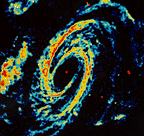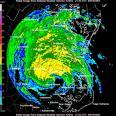|
Radio waves are very long compared to
other waves from the electromagnetic spectrum. They are emitted by planets in our solar system, chemicals in comets and in the Milky Way Galaxy, supernovae, and by other galaxies and distant quasars.
They bring us information about all of these celestial objects. Most
radio radiation reaches the ground and can be detected during the day as
well as during the night. These radio waves travel through space just like light, and radio telescopes can intercept them. Astronomers often convert these signals into pictures. Well, how do they do this?
Radio telescopes look like the picture below. The dish of a radio telescope is made of metal and has a parabolic shape. The 140' telescope, pictured here, is pointing at an object in the universe. Radio waves emitted by that object hit the surface of the dish, and bounce.  Because the dish is shaped the way it is, those waves all bounce up to the tip of the telescope, the focal point. The radio waves enter a sensitive receiver there. and are converted into a signal that can be stored in a computer. Astronomers use computers to turn this information into an image. The image consists of pixels. The data in the pixels is directly related to the strength of the radio wave. The pixel records a large number when the wave is strong and a small number when it is small. The computer then maps these pixel numbers into colors assigned by the engineer or graphics professional running the radio telescope data processing. Because the dish is shaped the way it is, those waves all bounce up to the tip of the telescope, the focal point. The radio waves enter a sensitive receiver there. and are converted into a signal that can be stored in a computer. Astronomers use computers to turn this information into an image. The image consists of pixels. The data in the pixels is directly related to the strength of the radio wave. The pixel records a large number when the wave is strong and a small number when it is small. The computer then maps these pixel numbers into colors assigned by the engineer or graphics professional running the radio telescope data processing.

The study of the radio universe brought us the first detection of the
radiation left over from the Big Bang. Another use of radio waves is in weather radar. To the right is a picture using weather radar: The general qualifications for weather radars are 1) a wavelength between 1 and 30 cm, 2) pulsed transmission with high peak power (kilowatts to megawatts), 3) relatively narrow beam widths, 4) pulse lengths of a few microseconds or less, 5) pulse repetition frequencies of several hundred hertz, and 6) automatic azimuth or elevation angle scanning.
|






 Because the dish is shaped the way it is, those waves all bounce up to the tip of the telescope, the focal point. The radio waves enter a sensitive receiver there. and are converted into a signal that can be stored in a computer. Astronomers use computers to turn this information into an image. The image consists of pixels. The data in the pixels is directly related to the strength of the radio wave. The pixel records a large number when the wave is strong and a small number when it is small. The computer then maps these pixel numbers into colors assigned by the engineer or graphics professional running the radio telescope data processing.
Because the dish is shaped the way it is, those waves all bounce up to the tip of the telescope, the focal point. The radio waves enter a sensitive receiver there. and are converted into a signal that can be stored in a computer. Astronomers use computers to turn this information into an image. The image consists of pixels. The data in the pixels is directly related to the strength of the radio wave. The pixel records a large number when the wave is strong and a small number when it is small. The computer then maps these pixel numbers into colors assigned by the engineer or graphics professional running the radio telescope data processing.